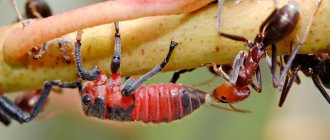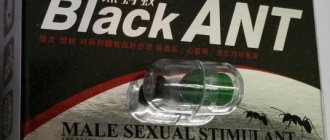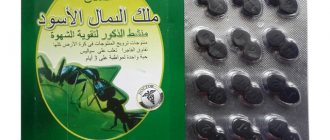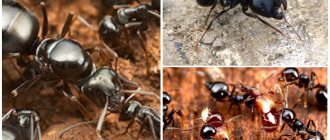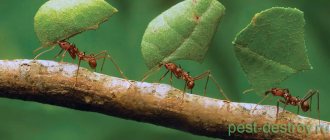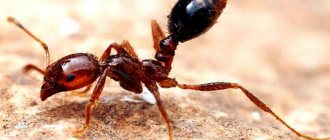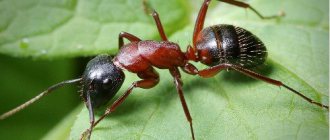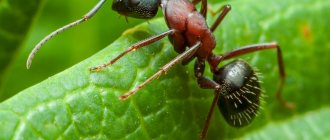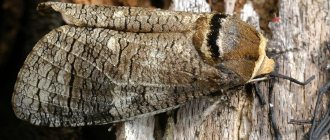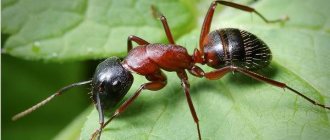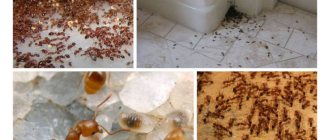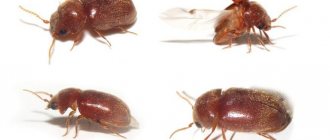Black carpenter ant (Camponotus vagus): distinctive features
Black carpenter ant (Camponotus vagus), appearance
An insect can be identified by color and size. Despite this, representatives of this species are often confused with other ants that live in forests. The insect also has an extremely similar physique to its close relative, the red-breasted carpenter ant.
External characteristics
The black carpenter ant (Camponotus vagus) is large in size: the body length of females is 1.5-1.7 cm, soldiers are slightly smaller than females, males are 1-1.2 cm, workers are 0.6-1.3 cm The color is black, shiny, without any admixtures of other shades. The antennae are geniculate. The eyes are medium-sized, black. The head is large and wide. There are light silvery hairs on the abdomen. The lower edge of the clypeus is straight.
The eggs are small and have an elongated shape. The color is white, often with a slight hint of yellow. Insect larvae have pronounced segmentation. The body color is similar to the eggs. The body is shiny, translucent.
Spreading
The black carpenter ant lives exclusively in forests. This insect can be found in Europe and Northern Asia: in the Crimea, Western Siberia, Kazakhstan, Turkey, the Urals, and the Caucasus. It also lives in northwest Africa.
Under unfavorable conditions, ants hide in underground passages. They prefer deciduous trees. The largest populations are seen in places with high humidity.
Features of the system
The life of lasius niger is to provide the uterus with basic nutrients. Each group of individuals has its own responsibilities:
- breeding offspring;
- anthill protection;
- food production.
The lifespan of females is significantly longer than males. Males die almost immediately after mating. Therefore, the average life of a male lasts no more than a month, and a female lives up to 1 year.
There can only be one queen in one anthill. Sometimes a larger number is possible at an early stage of colony development. Afterwards, the flying females themselves fly out of the anthill, look for places to lay eggs and create their own colony. You can see the differences even by looking at a photo of black ants. Females and males have wings; workers do not have them. The queen initially also has wings, which she later chews off herself.
Big black ants in the garden
Interesting!
Fertilization of the female garden ant occurs during the mating flight.
The larva of this type of ant is a sedentary worm with a whitish color. After reaching the required age, nurse ants help new individuals to be born. They break the egg.
Lifestyle of black carpenter ants
The nests of black carpenter ants are most often located in rotten tree stumps. Sometimes Camponotus vagus can be seen in hollows and wooden buildings. Like other members of the family, these ants live in large colonies. All individuals are divided into groups depending on their responsibilities:
- builders;
- hunters;
- nannies;
- soldiers;
- females;
- males.
Most arthropods belong to the first 3 groups. The lifespan of females is up to 28 years. Males live the shortest - they die immediately after mating. Apart from them, hunters have the shortest life expectancy, who rarely live up to 3 years.
The black carpenter ant is active during the daytime. Rarely leaves the shelter in cloudy weather. The only ones who are active at any time of the day are the soldiers. Among all the worker ants, the most common are builders.
Reproduction
Females and males capable of mating make up only a small part of the offspring. In the spring, at the end of April - beginning of May, they leave the anthill and go in search of partners. These individuals have wings, thanks to which they can move long distances. Mating occurs in the air. The fertilized female is looking for a place suitable for building a new anthill. There she chews off her wings, and her activity noticeably decreases.
The queen raises her first offspring on her own. One female mating is enough for the rest of her life. Thus, after the first offspring becomes adults, the female stops leaving the anthill. Nurses help the queen take care of subsequent larvae and eggs. However, the female still makes a large contribution to caring for the offspring.
Black carpenter ant (Camponotus vagus), dimensions
Black carpenter ant, appearance of jaws
Black carpenter ant (Camponotus vagus) on a branch
Description of the species
Lasius niger ants prefer to live in a large colony, the number of which can reach several thousand individuals.
The main thing in the anthill is the uterus. She is also the largest individual. The queen of black ants can reach 1 cm in length. The size of the working insect is up to 5 mm. The female is slightly shorter in length than the male. Its size does not exceed 4.5 mm, and the male grows up to 5.5 mm. The color of individuals ranges from dark brown to deep black. The entire body of the insect is covered with very short hairs. Large black ants choose garden plots, tree trunks, hollows, and stumps as habitats.
Interesting!
The queen of this species can live for about 28 years.
Small invertebrates serve as food for insects, but most of all ants prefer to eat sweet honeydew, which is secreted by aphids.
Why is the black carpenter ant dangerous?
The carpenter ant is useful for nature: it cleans forests of small parasites and fungi, and also loosens the soil, but for humans the ant can be a pest.
The insect reproduces quickly and is unpretentious to living conditions. Carpenter ants do not feed on wood. It makes tunnels in it, reducing the strength of the material and promoting rot. It is important to know that the black carpenter ant often damages supporting structures near the base. This creates a risk of the building collapsing.
Like other types of ants, the black carpenter ant can bite humans. Although such a bite does not pose a significant threat, it can cause an allergic reaction. It manifests itself especially often in young children.
Allergy symptoms most often include:
- nausea;
- labored breathing;
- pale skin;
- tachycardia;
- dizziness.
Camponotus vagus are quite aggressive ants. Their bites are extremely dangerous for newborns.
It is also important to consider that the black carpenter ant is a carrier of many diseases. Infection can occur through any objects that have been visited by pests.
Carpenter ants can carry the following diseases:
- salmonellosis;
- helminthiasis;
- dysentery;
- cholera;
- typhoid fever.
Rarely does an insect cause diphtheria infection.
The carpenter ant poses a serious threat not only to people, but also to pets. It can carry such dangerous diseases for animals as parvovirus enteritis.
The pest often damages food. It is important to understand that eating such food is unacceptable. This is justified not only by the low nutritional value and lack of useful elements, but also by the extremely high risk of infection by diseases carried by the carpenter ant.
Signs of infection
Black carpenter ants are fairly easy to spot because they do not hide and are most active during the daytime. In addition, insects constantly follow certain routes and always move in large groups. In places where ants create tunnels, wood dust remains.
Fighting methods
Chemical remedies for ants
You can get rid of carpenter ants using folk remedies and professional preparations.
- Insects can be thoroughly destroyed with a concentrated emulsion. The drug is diluted in water, walls, furniture, and floors are sprayed. Broad spectrum insecticide causes paralysis and death. Mass mortality is observed after 2 weeks.
- Poisonous baits save you from disaster if you cannot find the nest or it is difficult to get to the queen. The composition contains insecticide, flavorings, and food additives. The insects eat the poison themselves and drag it into the nest. They feed other relatives, larvae, and the queen. Death occurs a few days after the poison enters the stomach. Carpenter ants, suspecting nothing, continue to carry poison into the nest.
- You can poison a carpenter ant with boric acid by combining it with food products - sugar, honey, cookies with milk, jam, boiled yolk. Place baits in places where insects move.
- You can expel them from the premises and prevent re-infection with garlic, tansy, mint, wormwood, as well as ammonia, vinegar, and birch tar.
The carpenter ant is protected and killing the insects outside the home is illegal.
How to deal with carpenter ants?
The most effective way is to destroy the nest. You can find it by following Camponotus vagus. Also around this place there are usually the largest accumulations of trash. It should be borne in mind that repellent methods and traps have practically no effect on the black carpenter ant.
Insecticides
They are the most effective and basic way to combat pests. However, it is important to understand that such drugs often cause allergic reactions, so they can pose a danger to children, pets, and people with hypersensitivity.
The following insecticides are considered to be most effective against ants:
Gel bait “Great Warrior”
Contains two active substances: diazinon and chlorpyrifos. The gel contains food fillers that attract insects. The workers not only eat it themselves, but also bring it to the anthill to feed the larvae. Using this tool you can destroy the entire colony of ants. Pests completely disappear after 1.5-2 weeks of using the gel.
Con
A budget-friendly product for controlling ants in the garden. The active ingredient is diazinon. The drug has a low consumption - 1 ml is enough to destroy 10 anthills. The ants disappear within three days after treatment. The protective effect lasts for three weeks. The product is not addictive. The product is safe for beneficial soil bacteria.
Gel “Clean House”
The active ingredient is chlorpyrifos. The gel is sold in a syringe; it is convenient and easy to use. The product is safe for people and pets: it contains bitter components, thanks to which pets do not try to eat it. The drug destroys insects in just three days, the validity period lasts about a month.
Con
The active substance is deltamethrin. Hazard class for humans – 3 (moderately dangerous). It has low consumption and a wide spectrum of action. It is also characterized by a high speed of action and the absence of a strong unpleasant odor. The residual effect can last up to 6-8 weeks.
Sinuzan
The active ingredient is chlorpyrifos. Hazard class for humans and pets – 3. The main advantage of the chemical preparation is its high efficiency. The product affects insects at any stage of development, including eggs and larvae. Not addictive. The residual effect lasts up to 1-2 months. It should be borne in mind that the insecticide has a rather strong odor and often causes an allergic reaction. If all safety rules are not followed, the likelihood of serious poisoning is extremely high.
Microencapsulated insecticide "Minap-22"
This is a professional product used by pest control organizations. The active ingredient is chlorpyrifos. The product belongs to hazard class 4 for mammals (low danger). This insecticide has a long shelf life (up to 12 months) and is economical in consumption. Another advantage is the absence of a pungent odor. You need to know that the drug can be addictive in insects. For this reason, it is recommended to avoid repeated treatments with products containing chlorpyrifos.
Microencapsulated insecticidal agent "Effective Ultra"
The drug belongs to professional pest control products. This insecticide contains a whole list of active ingredients: dicarboximide, piperonyl butoxide, propoxur and tetramethrin. Hazard class for humans – 4. Validity period can reach up to 2-3 months. The product is odorless and has a wide spectrum of action. In addition, it is not addictive.
Aerosols are used less frequently against ants. But keep in mind that the effectiveness of such insecticides is too low to completely destroy the population. The aerosol should be used after 17:00, because in the evening the ants return to the nest. You need to direct the product directly into the nest and repeat the procedure at least 3-4 times.
In this case, the aerosol cannot be applied to ant paths, since in this case the pests will simply change their route.
Popular aerosols are:
- "Raptor";
- "Regent";
- "Dichlorvos".
The use of crayons is also acceptable. The most popular are the “Mashenka” chalk and the “Titan” chalk. Such products are very easy to use and also have relatively high effectiveness. However, they should not be used in the presence of pets or children.
Traditional methods
If you have access to an anthill, then the best and most effective option for getting rid of insects is to pour boiling water or acetic acid over it.
Please note that there may be smaller nests next to large and old nests, so it is important to find and destroy everything, otherwise you will not be able to get rid of the ants.
To combat carpenter ants, you can mix 2 tablespoons of carboxylic acid with black and laundry soap and dilute with water. Fill the anthill with the resulting solution 3 times a day, repeat the procedure two days in a row.
If the anthill is located in a hard-to-reach place or has not been discovered, then pest control will be more difficult. In this case, most traditional methods will not be as effective. Some of them can be used for preventive purposes.
Pests are repelled by:
- hot red pepper (ground is best);
- vinegar;
- any citrus fruits;
- garlic;
- sagebrush;
- cinnamon;
- black soap;
- turmeric;
- tomato leaves;
- curry.
You need to place ant-repellent products near their home, then there is a high probability that the insects will leave it. You can also place repellents on ant paths; they will help eliminate the pheromone trail of insects along which they navigate.
You can place wormwood, elderberry, mint, and lavender in the rooms. The aroma of plants will repel pests.
If a problem with ants occurs on your property or in a greenhouse, it is recommended to plant lavender, lemon balm, rosemary, heel, parsley, fennel and nasturtium in the inter-row spaces.
Sweet traps are considered an effective option. To do this, you need to mix 250 ml of warm water, 60-90 g of sugar and about 15 g of dry yeast. It is acceptable to add honey to the solution. The ants will crawl into the trap, but will not be able to get out of it. Periodically, traps need to be cleaned of pests that have entered them.
You can also make traps from boric acid. To do this, you need to mix it with sugar or honey, put it in saucers and leave it next to the anthill.
If there are ants in the house, you can cover all baseboards and the intersections of walls and furniture with double-sided tape. The ants will get onto the tape, but will no longer be able to get out.
Preventive measures
Insects are especially attracted to damp and rotten wood. Therefore, it is extremely important to get rid of any sewer leaks and periodically ventilate the premises. In addition, you should adhere to the following prevention rules:
- Regular cleaning. In this case, you can use wormwood tincture, a solution with a low vinegar content, and detergents. Such wet cleaning allows you to scare off ants in advance.
- Reducing the number of cracks and cracks. The presence of shelter significantly increases the likelihood of a pest occurrence. Most often, the insect settles in wooden walls and baseboards.
- Disposal of garbage in the area adjacent to the house. Black carpenter ants prefer areas where there is a lot of fallen leaves and twigs. In addition, old building materials can become a temporary shelter for them.
If trees or bushes grow near your house, you need to monitor their condition. It is highly not recommended to plant woody plants close to the house. This significantly increases the risk of infection. Old and diseased trees require special attention, since the black carpenter ant most often settles on them. Stumps should be uprooted, especially when there is high humidity or beginning to rot.
Signs of pests
If piles of light-colored dust, similar to very fine sawdust, begin to appear in the house near the walls, the walls need to be inspected in search of an area affected by pests. A tree attacked by carpenter ants will be riddled with cracks and holes. Parasites can settle not only in the wall, but also in closets, hollow doors, and lintels. Wet wood is especially susceptible to woodworm attacks.
If the exact location of the nest is unknown, bait is placed next to the supposed ant path: honey, sugar, syrup, and the insects carrying the prey home are tracked.
The methods for getting rid of woodworms in a wooden house after discovering their nest are similar to those used to remove ordinary house ants.
On a note!
If the nest is located in an easily accessible place, it can simply be destroyed.
Morphology
Imago. Body size – 16–18 mm. The abdomen is matte, completely black or with a small reddish spot at the base. The chest is dark or brownish red. The scales and legs are red. Like all representatives of the ant family, the clypeus is clearly distinguished on the head, behind it is the frontal platform, and on the sides of the platform are frontal ridges. The antennae are twelve-segmented, articulated at the frontal carina at a considerable distance from the posterior edge of the clypeus. The clypeus is convex, with a rounded anterior edge. The antennal and clypeus pits are separate and unconnected. The chest in profile is uniformly convex, without depression. Epinotupe without spines and teeth. The red-breasted carpenter ant has mandibles with 4–5 teeth, the clypeus does not protrude forward. The cheeks are without hair-bearing pits; the clypeus has only two pits near the anterior edge.
Female. Size – 15–18 mm. Winged only during mating flight.
Male. Size – 9–11 mm, black, winged. Life expectancy is short.
The workers are large – 6–14 mm, with a massive, wide, almost square head and a high, dense chest. Always wingless.
Egg. Like all representatives of the ant family, the eggs are white, small, round in shape, 0.1–0.8 mm long. The integument is thin, delicate, almost transparent, white or slightly yellowish. Newly laid eggs are microscopically small and individually not visible to the naked eye. But you can notice them because they are collected in packages.
Larva. Like all members of the family, the larvae after hatching are small, 0.2–0.5 mm long, almost oval, whitish or yellowish. The body is worm-shaped, almost naked, consists of a head, three thoracic and ten abdominal segments, sharply narrowed in the first quarter, hook-shaped. The antennae are not developed and are represented by small rounded tubercles. No eyes. The oral organs consist of small mandibles narrowed at the ends, even less developed jaws and a lower lip.
Insect housing
An arboreal arthropod builds a nest inside a dry tree, an old stump. You can always see the presence of small holes - entrances and exits, and sawdust near the nests. Their type and quantity makes it possible to determine the age of construction, as well as the number of individuals in the colony. It is worth noting that such an anthill can serve as an excellent landmark for a lost traveler.
Individuals are always working here. Woodworms of various sizes can be found near their home. For example, soldiers are distinguished by the presence of a large head, their body is no more than three millimeters long, and are characterized by slowness and caution. The soldiers perform the function of observing what is happening, assessing the safety of the situation. The smallest representatives are working individuals.
The working clan is engaged in the process of building a house, every day they increase the number of tunnels, passages and chambers underground. It is worth noting that at night insects sleep, but not guard soldiers. Speaking about the winter period, in cold weather all movement occurs only underground in the created passages.
Nutrition
Large black ants in the garden find food for themselves, their larvae. Adults feed on plant juices, a sweet secretion secreted by aphids. To obtain food, ants spread aphids throughout the garden, providing them with the most succulent trees in the country. Behind it they collect honey dew.
Ants' habitat
Interesting!
Black ants keep aphids in their home in a special chamber. They provide her with adequate nutrition, tickle her with antennae, and receive a sweet delicacy.
The larvae are more voracious. They need protein foods. Adults bring them insects, worms, and slugs. These feeding habits make black garden ants useful and harmful. Insects will destroy small pests and spread aphids themselves, causing significant damage to crops.
Professional services
If traditional methods do not lead to a positive result, you should turn to professionals.
Experts will ensure quick and effective removal of black ants, as they have great capabilities to eliminate them.
This method is good if you have the opportunity to leave the apartment for several days in order not to be exposed to toxic substances and chemicals.
Professionals completely treat every area in the room with special solutions, from which black ants die instantly.
IMPORTANT: Insects can return to the apartment again if they live with your neighbors. Therefore, it is necessary to fight against black ants through the joint efforts of all owners of adjacent apartments
Feeding intensity
Once a day or once a week: how often to feed the ants and how much food should be given - this question is no less important than what to feed the colony. The colony needs to be fed regularly, but in small portions
, especially when we are talking about a small anthill for 30-100 insects.
If the ant gets a little hungry, it’s okay. But if the food goes bad, it poisons the colony - then disaster will happen. Therefore, portions must be calculated so that they are eaten within a few hours. Only practice will help here.
Note:
if new individuals of ants become smaller in size, then the colony does not have enough food, it is necessary to increase the food supply and diversify the diet. By doing this on time, the keeper gets rid of problems with the colony in the future.
Insects usually throw away excess food. Not eaten is a sure sign that you should put less in size or quantity next time, but it is better to take a break from feeding.
Behavior
The black garden ant is a non-aggressive creature with a poisonous sting. They use weapons to hunt when enemies attack when danger approaches. The insects bite quite hard, leaving an inflamed red mark. For a person prone to allergies, an ant bite can be a serious health problem.
Interesting!
There are always several adults on guard. In case of danger, they give a signal to the others and massively attack the enemy. In the blink of an eye, a whole colony of insects appears at the feet of a person passing by an anthill.
An insect doesn't bite like that. He will crawl freely along his arm and leg if nothing threatens him. The slightest pressure on the body leads to a defensive reaction.
On a note!
In nature, there are a huge number of giant black ants that can bite pets to death and cause significant harm to human health. This type of ant lives in tropical countries. When insects are discovered, residents leave the house, taking the entire family with them.
Ant diet: how and what to feed ants in an ant farm
The question of how and what to feed ants in an ant farm is quite popular among beginners and even experienced myrmecologists. Colony survival depends on nutrition
, and standard food may not be enough for this. A varied diet enriches ants with vitamins and prolongs their life. While monotonous food can cause pestilence among insects.
